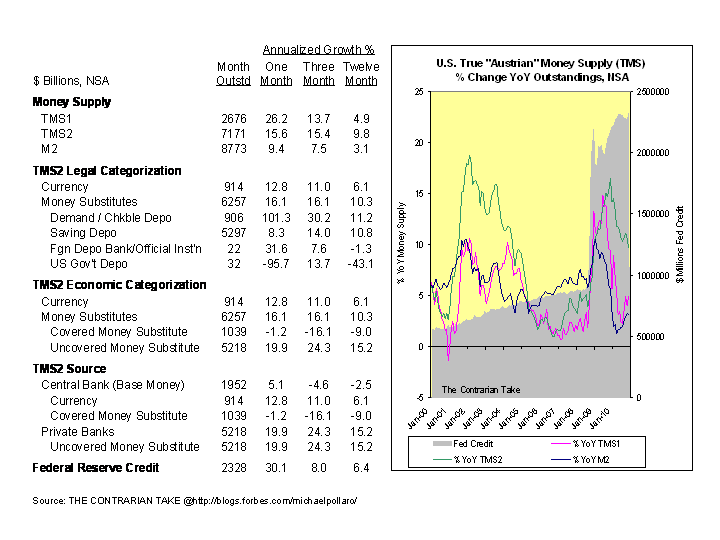Monetary Watch December 2010: The Money Supply, a Triple From Here?
Interest-Rates / Money Supply Dec 22, 2010 - 11:22 AM GMTBy: Michael_Pollaro
 Our monthly Monetary Watch, an Austrian take on where we are on the monetary inflation front and what’s next…
Our monthly Monetary Watch, an Austrian take on where we are on the monetary inflation front and what’s next…
Headline Monetary Aggregates in November
The U.S. money supply aggregates based on the Austrian definition of the money supply, what Austrians call the True Money Supply or TMS, were mixed in November, with our shorter-term one and three-month rate of change metrics continuing their recent surge while our longer-term twelve-month rate of change metrics showing some moderation. Focusing on TMS2, THE CONTRARIAN TAKE’s preferred money supply measure, we find that it increased at an annualized rate of 15.6% in November, bringing the three-month rate of change to an annualized 15.2%. That’s up from October’s 14.5% rate and 13.3% rate, respectively. In contrast, the twelve-month rate of change metric on TMS2, the measure we watch most closely, went the other way, ending November at a rate of 9.8%, down from October’s 10.5% rate, and marking the end, albeit barley, of 22 consecutive months of double digit increases.
As has been the case throughout 2010, M2, the mainstream’s favorite monetary aggregate, continues to show subdued growth, in November posting a year over year rate of increase of 3.1%, down from October’s 3.2%. As readers of this site are aware, THE CONTRARIAN TAKE posits M2 as a grossly misleading measure of the money supply, meaning the gap between the true and the perceived rate of monetary inflation is a healthy 6.7 percentage points.

A Return to Double Digit Increases in the Offing?
We must say that we were a bit surprised by that 9.8% twelve-month rate of change print on TMS2. As we argued in last month’s Monetary Watch, we were expecting TMS2’s 22-month string of double digit rate of change increases to continue well into 2011. Yes, it fell short by only 2 bps, but double digits it was not. We do think though that a return to double digit rate of change increases are in the cards, for three reasons…
First, the recent surge in TMS2 – up an annualized 10% the past six months and 15.2% the past three – should be supportive of higher twelve-month rate of change increases over the coming months.
Second, the full impact of the Federal Reserve’s QE II asset purchase program was not felt in the money supply aggregates. Coming as it did mid-month, plus what appears to be a larger than projected draw-down in the Federal Reserve’s Agency portfolio, QE II yielded an annualized impact of just $600 billion in November instead of the projected $900 billion.
Third, and most important, private banking institutions are not only continuing to print money, but appear to be doing so at an accelerating rate. In fact, Uncovered Money Substitutes, i.e., bank deposit liabilities not covered by bank reserves, the issuance of which is the result of the banking systems’ efforts to lever up its loans and investments on top of what is currently a mountain of excess reserves, is growing at a year over year rate of 19.9%, a post credit crisis high.
By Michael Pollaro
Michael Pollaro writes a column called THE CONTRAIAN TAKE at True / Slant.com, its mission statement to present thoughts and ideas on important financial market and economic trends from the perspective of a free-market, Austrian economist.
Michael Pollaro is a retired Investment Banking professional, most recently Chief Operating Officer for the Bank's Cash Equity Trading Division. He is a passionate free market economist in the Austrian School tradition, a great admirer of the US founding fathers Thomas Jefferson and James Madison and a private investor.
Website: http://trueslant.com/michaelpollaro/ Email: jmpollaro@optonline.net
Copyright © 2010 Michael Pollaro - All Rights Reserved Disclaimer: The above is a matter of opinion provided for general information purposes only and is not intended as investment advice. Information and analysis above are derived from sources and utilising methods believed to be reliable, but we cannot accept responsibility for any losses you may incur as a result of this analysis. Individuals should consult with their personal financial advisors
© 2005-2022 http://www.MarketOracle.co.uk - The Market Oracle is a FREE Daily Financial Markets Analysis & Forecasting online publication.



